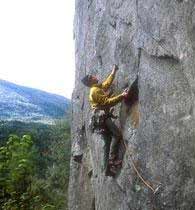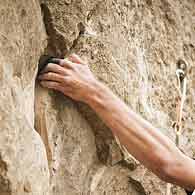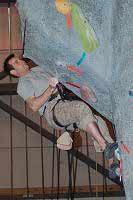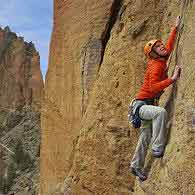VOICE ONE:
I'm Doug Johnson.
VOICE TWO:

And I'm Bob Doughty with EXPLORATIONS in VOA Special English. Some people say the higher you climb, the harder you fall. But those people probably would not be rock climbers. The sport, science and art of rock climbing is our subject this week.
(MUSIC)
VOICE ONE:
An estimated nine million people rock climb in the United States. Millions more take part in the activity around the world. Some do it just for personal satisfaction. Others compete. Rock climbing can be dangerous. But there are many methods and protective devices that can increase a climber's safety.
Climbing takes strength, control and good balance. Climbers have to pull themselves straight up the face of very high rocks or walls. So they have to be strong enough to carry their own weight. And climbers sometimes have to hold on to rocks by only their fingers or toes.
VOICE TWO:
There are several kinds of rock climbing. Traditional rock climbing is done outside. Climbers wear ropes and attach devices to the rocks as they climb many hundreds of meters up. They also connect their ropes to the devices. If a climber slips, a rope can stop him from falling.
Sport climbing is similar. However, in those cases the protective devices are permanently placed in the rock. There is also indoor climbing. Rock walls made of wood or concrete have places for the climber's hands and feet.
Ice climbing is exactly as it sounds. People climb glaciers or frozen waterfalls instead of rocks. They use special equipment for the ice.
And then there is bouldering – climbing rocks between three and seven meters high. It is a quicker and more intense kind of climbing. Many climbers like bouldering because they can use less equipment. Climbers often need only special shoes and chalk. All climbers use chalk to keep their hands dry.
(MUSIC)
VOICE ONE:
Most rocks have cracks and holes and parts that stick out. Climbers use these for footholds and handholds. Sometimes the rock curves into an overhang. Then a climber has to try to move sideways as she moves forward to try to avoid hanging completely upside down.

Climbers use their legs to climb. They try not to pull themselves up with their hands or arms. Arms and hands are for position and balance. Climbers often need to lock their bodies to the rock with one small finger hold.
People almost always climb in groups of two or more. Climbing alone, or "solo climbing," is very dangerous. Expert rock climbers say only the very best in the sport should do it.
VOICE TWO:
In a group climb, the first climber is the lead climber. He has a rope attached to his harness. The harness goes around the middle of the climber's body and in between his legs. The second climber is called the belayer. The lead climber's rope goes through a belay device. It is attached to the belayer's harness. The belayer then gives more rope up to the lead climber as he moves up the rock.
The lead climber attaches his rope to devices in the rock as he climbs up. If he falls, he is protected by the rope connected to the devices and to the belayer. But, the lead climber can only do this for about 25 meters, the length of the climbing ropes. If the lead climber were injured in a fall from any higher up, the belayer could not get him down. Later, the lead climber and the belayer change places. They meet where the first climber has stopped. Then they start to climb again.
(MUSIC)
VOICE ONE:
Sarah Bowman is a 26-year-old rock climber in Alexandria, Virginia. She started climbing a year and a half ago. Her first experience with the sport probably was not the usual kind. It was during a trip to Alaska.
SARAH BOWMAN: "So, I ran a marathon and two days later I went ice climbing on a glacier. And, then I decided to come back home and see if there was a gym..."
She says she fell in love with the sport.
SARAH BOWMAN: "It's sort of like a world on its own. There's no other sport where you're really going up and down. Everything else is across the ground. In basketball you go up a little bit, but not anywhere near as cool. So I think most people either love it or hate it. There's really no in between."
Miz Bowman continued her training.
SARAH BOWMAN: "So, I'm also now a wilderness EMT so it's totally a good thing to have when you're out rock climbing."
VOICE ONE:

Miz Bowman works at an indoor climbing center. She says all climbers go to these centers in the winter when it is too cold to climb outdoors. At indoor centers, climbers have many different paths they can use to get to the top of the walls. The possibilities are marked by tape of different colors. If you start a path of one color you must continue to use only toe and handholds marked with that color. The different paths have different levels of difficulty. While our reporter was there, Sarah Bowman succeeded at a personal best.
VOICE TWO:
The Sportrock Climbing Center is busy even at 9:30 on a Monday night. An equal number of young men and women crowd around several different climbing walls. Climbers stretch their bodies in ways that do not seem possible while hanging in positions that do not seem to obey the laws of physics. They try to move as silently up the wall as they can. Sarah Bowman says being quiet is considered an important climbing skill. However, fans on the ground cheer them on as they climb up the wall.
(MUSIC)
VOICE ONE:
This past summer the rock climbing world mourned the loss of one of its greatest stars. John Bachar was 52 years old when he fell from Dike Wall near his home in Mammoth Lakes, California. He was doing what he was famous for -- free-solo climbing. This is climbing without protection and alone.
John Bachar was born in Los Angeles and became famous in Yosemite Valley in California. That area of Yosemite National Park is the traditional international center of rock climbing.
Mr. Bachar started free-solo climbing in the 1970s. He was a member of a group of climbers called the Stonemasters. Another climber, John Lang, suggested Bachar free-solo an area called Double Cross, in Joshua Tree National Park, California. John Bachar accepted the dare and never looked back.
By 1981, John Bachar proposed a dare himself. He offered 10,000 dollars to anyone willing to follow him on a one-day climb without a rope. No one accepted.
VOICE TWO:
Dean Fidelman is a professional rock climber who was a close friend of John Bachar. We spoke to Mr. Fidelman as he was climbing. He said John Bachar often compared himself to a dancer who was always working on his dance. Mr. Bachar was known for his slow, smooth and controlled movements while climbing.
Dean Fidelman said that he believes a climber's ego can be his worst enemy on a rock. He said rock climbing is a high risk sport in which many people overestimate their abilities and underestimate the rock.
VOICE ONE:

A recent study shows a sharp increase in rock climbing injuries between 1990 and 2007. The Center for Injury Research and Policy at Nationwide Children's Hospital in Ohio did the study. It was published in the American Journal of Preventative Medicine. The study found a 63 percent increase in the number of people treated for rock climbing injuries in American hospitals.
The study said 40,000 people were treated in emergency rooms. The most common injuries were broken bones and sprains in legs and feet. The ankle was the most common body part to be injured.
Climbers in the study were from ages two to 74. The average age was 26. 56 percent of the injuries were to people 20 to 39 years old. Women made up 29 percent of the injured population. That is more than in past rock climbing studies.
VOICE TWO:
Like many other sports, rock climbing can be dangerous. But many people think it is worth it. John Bachar said rock climbing felt like being on another planet. Dean Fidelman says it is a continual challenge and a beautiful form of movement. And, for Sarah Bowman, she has just started her way up the rocks.
(MUSIC)
VOICE ONE:
This program was written by Caty Weaver and Marisel Salazar. Dana Demange was the producer. I'm Doug Johnson.
VOICE TWO:
And I'm Bob Doughty. You can download podcasts and comment on our programs at our Web site, voaspecialenglish.com. Join us again next week for EXPLORATIONS in VOA Special English.
Related stories:
The Great Lakes and famous shipwrecks
Getting a feel for textile arts around the world
Hip-Hop goes global to a socially active beat
Exploring the magical world of puppets
(来源:VOA 编辑:陈丹妮)